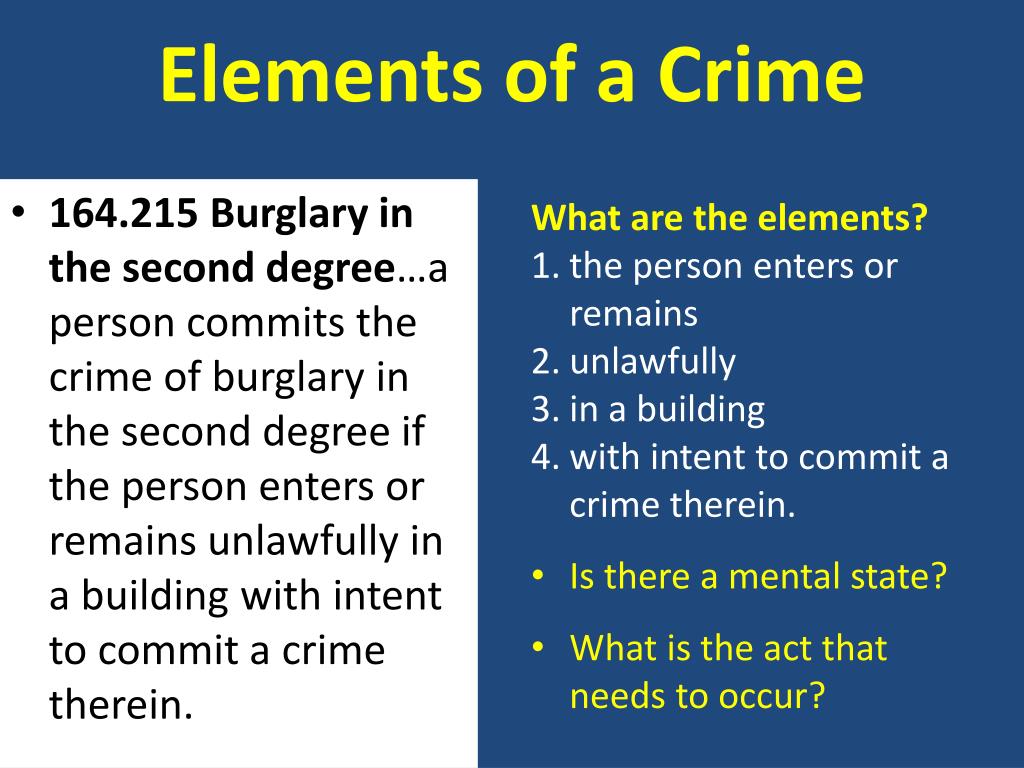In a legal context, motive is the reason a person may have committed a crime. … This was put forth as proof of Friend’s motive in fleeing from and shooting at the police officer. Motive is not always necessary to prove a crime, as other evidence may be sufficient.
What is opportunity in elements of crime? Opportunity makes the Theft Opportunity is one of the elements of crime for it to occur. It is the cause of all crime to happen. … The lack of any of these elements is capable enough to prevent the occurrence of a successful direct-contact predatory crime.
What is an example of a motive?
The definition of motive is causing action. An example of motive used as an adjective is the phrase a “motive idea” which means an idea that inspires someone to act. Motive is defined as a reason for doing something. An example of a motive is the reason for committing a crime.
Is motive indicative of criminal intent? Intent is an element of just about every crime, meaning that the prosecution must establish that the defendant intended to commit the criminal act. … But motive usually isn’t a criminal element—the prosecution doesn’t have to prove the defendant had it.

Can a crime be committed without criminal intent?
It is important that court shall prove that the defendant is guilty beyond reasonable doubt in order to avoid convicting an innocent individual of any crime. On the other hand, even without such criminal intent, a person may be convicted of a crime under special laws or felonies due to fault or negligence.
Which are two kinds of opportunity theory?
Crime Opportunity Theories: Routine Activity, Rational Choice and their Variants.
What are the 5 dimensions of criminal opportunity? The criminal event has five dimensions: space, time, law, offender, and target or victim.
Is crime all opportunity? Crime opportunity theory suggests that offenders make rational choices and thus choose targets that offer a high reward with little effort and risk. … All crimes require opportunity but not every opportunity is followed by crime.
What are 3 types of motives?
Psychologists have divided motives into three types—Biological motives, social motives and personal motives! The goal here may be fulfillment of a want or a need.
What are the three basic motives? McClelland’s human motives model distinguishes three major motives: the need for achievement, affiliation, and power. The power motive stems from a person’s desire to influence, teach or encourage others.
Why is motive important? Motive plays an important role in criminal law. It is necessary to prove liability for some offenses; it is a key component of several defenses; and it has been a traditional consideration at sentencing.
What is the difference between a motive and intention? Although motive and intent are often used interchangeably, they are distinct concepts in criminal law. Motive deals with an individual’s underlying reasons for committing a crime, whereas intent is concerned with their willingness to carry out specific actions related to the offense.
How far is motive and intention relevant in criminal law?
The primary difference between intention and motive is that intention specifically indicates the mental state of the accused, i.e. what’s going on in his mind, at the time of the commission of a crime, whereas motive implies the motivation, i.e. what drives a person to do or refrain from doing something.
Is motive relevant in proving a crime?
“Motive plays a part in proving cases based on circumstantial evidence, but it is not that the non-proving of the same should invariably result in rejection of the prosecution case. Lack of proof of motive is not a deal breaker for the prosecution,” the court observed.
What is equipoise rule? Answer: The equipoise rule in labor cases provides that where both parties in a labor case have not presented substantial evidence to prove their allegations, the evidence is considered to be in equipoise. In such a case, the scales of justice are tilted in favor of labor.
What if you commit a crime without knowing? As judges like to say, ignorance of the law is no defense to criminal charges. There are exceptions, but the overwhelming majority of crimes don’t require that the defendant know that his or her conduct is illegal.
How can I prove I have no criminal intent?
Motive standing alone is not enough to prove criminal intent. The Model Penal Code’s criminal states of mind ranked in order of culpability are purposely, knowingly, recklessly, and negligently. Purposely is similar to specific intent to cause a particular result.
How can we reduce criminal opportunity? The 10 Principles of Crime Prevention are:
- Target Hardening. Making your property harder for an offender to access. …
- Target Removal. Ensuring that a potential target is out of view. …
- Reducing the Means. …
- Reducing the Payoff. …
- Access Control. …
- Surveillance. …
- Environmental Change. …
- Rule Setting.
What is the example of opportunity theory? Crime Opportunity Theory suggests that when an individual wants to commit a crime, they look for an opportunity or a practical target. For example, if a city neighborhood offers no off-street parking, it may be a prime target for vehicle thefts.
Who came up with the crime opportunity theory? Richard Cloward and Lloyd Ohlin were criminologists writing in the 1960s about why young people commit crimes or turn to a life of delinquency rather than pursuing more legitimate paths. For Cloward and Ohlin, this is all about opportunity.
Who came up with the opportunity theory?
Richard Cloward and Lloyd Ohlin were two criminologists who wrote about these questions in the 1960s. Their work focused on how access to opportunities shapes life chances and influences the degree to which young people end up committing crimes. Let’s talk about their theory of delinquency and opportunity.
Who created the opportunity theory? A theory of delinquency and delinquent subcultures developed by Richard Cloward and Lloyd Ohlin in Delinquency and Opportunity (1960). Cloward and Ohlin made use of Robert K. Merton’s observations that …

